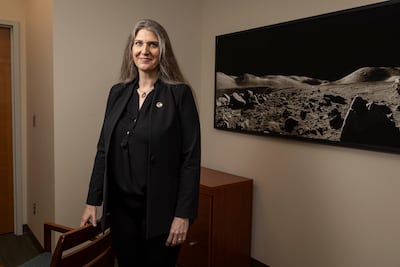Gateway, Nasa's Moon-orbiting station, is being designed so astronauts can travel on to planets such as Mars, officials have told The National.
The project, on which the Mohammed bin Rashid Space Centre in Dubai is a partner, is expected to be launched in 2027. The MBRSC is contributing the airlock module, which would enable astronauts to perform spacewalks, in exchange for sending an Emirati to the station on a mission.
The European, Canadian and Japanese space agencies are also developing components for habitation, power and propulsion.
Sean Fuller, the Gateway programme's international partner manager, told The National in an exclusive interview that he had “a lot of confidence” in the MBRSC and he was “excited to see” Emirati astronauts on the Gateway.
“Gateway is an international space station that we're building around the Moon with Nasa and our partners worldwide,” he said. His comments came as Nasa and its partners gathered in Dubai to discuss module designs and assess the contributions from each agency.
Launch pad to Mars
“We are in a location where we can have a whole crew vehicle come up and be a launch point to Mars from there,” Debra Ludban, Gateway vehicle systems integration manager at Nasa, told The National. “So, the whole point of the Gateway is to have a very robust architecture that can be modified in lots of different ways, used for lots of different things.”
Mr Fuller praised the design of the project and said astronauts would be able to explore the lunar South Pole, an area that is yet to be visited by humans, and that missions to Mars will come afterwards.
“You're not going to launch and go straight to Mars. There's a lot of technologies to ensure, to check out, to make sure you're ready to go and send crews there,” he said. “This has been the Nasa architecture and concept since 2018, and so it has a lot of support across the whole of US government, Congress, White House and bipartisan support as we look ahead to the future.”
Astronauts can also use the station to descend to the lunar surface using systems that SpaceX and Blue Origin are developing.

Uncertainty over Gateway’s future
While discussions in Dubai made steady progress, there is growing concern within the space community about the future of the Gateway, Orion spacecraft and the Space Launch System (SLS) rocket – critical elements of Artemis, the Nasa programme that aims to return astronauts to the Moon.
Shifts in US political priorities and potential budget constraints have led to fears that the lunar station project could be scaled back or even cancelled.
In his inauguration speech last month, US President Donald Trump referred to Mars, leading to speculation about Nasa’s priorities shifting from the Moon and towards the Red Planet.
There is also uncertainty over how astronauts would travel to the station, with reports that Boeing will cut 400 jobs in the SLS project – the rocket that would launch the Orion crew capsule. The job cuts would be a major setback for the programme, adding to long-standing concerns about cost overruns and delays.
Each launch of the SLS rocket reportedly costs about $4.1 billion, while billionaire Elon Musk has claimed that a fully operational Starship, another deep-space rocket, could launch for as little as $10 million a flight.
However, the flexibility of the project is essential, according to Ms Ludban. “The real intent is that Gateway is adaptable to whichever mission happens because we all know that as administrations change, things change, and so we are made to adapt that,” she added.
Promise of international collaboration
Mr Fuller also emphasised the significance of global partnerships in ensuring its long-term success. He said an Emirati astronaut aboard the Gateway in the near future would make a powerful case for international collaboration.
“International astronauts play a huge role in inspiring future generations," he said. "When people see someone who speaks their language, looks like them and shares their culture go to space, it makes exploration feel more tangible and achievable."
Ms Ludban said the MBRSC had acquired a lot of experience in the past 20 years. “Just in January, their MBZ-Sat had a very successful launch," she added. "They're getting amazing amounts of data. They're learning how to operate a vehicle in space, and we're just kind of building on all these successes that they've had over the last several years."
Nasa's Emirati astronauts complete training – in pictures







